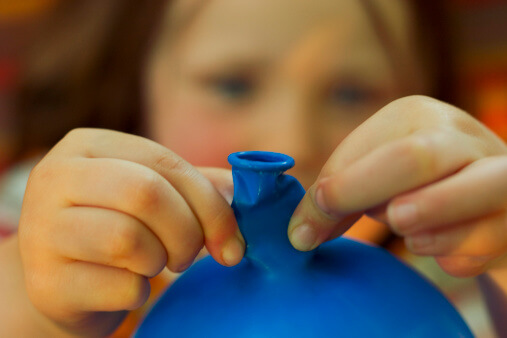REVEALED: The common party item that is a 'massive' choking hazard to young children
- Replies 7
Whenever the grandkids pay us a visit and come to stay with us, we can never let our guards down.
We, as adults, must always be very careful and aware of the food they eat and the toys they play with, especially around anything that could be considered a choking hazard.
In one of our previous articles, we featured Nikki Jurcutz, the founder of Tiny Hearts Education and a mum of two, who has been a paramedic with advanced life support experience for many years now.
She cautioned against a few everyday items, such as whole nuts and button batteries, that are potentially dangerous to little kids, especially if swallowed.
Ms Jurcutz is here once more to discuss a different choking risk that most adults seem to overlook while around kids.

A paramedic said that kids shouldn't be left alone with leftover balloons. Credit: Dr Alan Greene.
In one of the most recent videos uploaded on her TikTok channel, Ms Jurcutz brought up the issue of how dangerous it is to have leftover balloon rubber around young kids and how easily it might become lodged in a child's throat.
'I hosted a birthday party recently, and I was cleaning up and found this part of a balloon,' she said in the clip. 'These are massive choking hazards, and you need to be super careful around balloons.'
'As you can imagine, trying to do back blows to get this up when it's stuck would be near impossible, so be super vigilant!'
Choking is dangerous and can be fatal, but with a few simple rules, you can know what to do and how to keep it from happening to your loved ones.
1. The 'squish test'
Ms Jurcutz said that the 'squish test' is the first thing you need to know about choking. This test basically tells you if the finger food you're about to give your child is safe.
She suggested trying the squish test by 'pinching the snack between your pointer fingers and thumb'.
'This mimics the pressure of a toothless little one's gums,' said the paramedic. 'If the food squishes easily, it means it's safe, and bub will be able to chew. If it doesn't squish easily, you should cook, grate or mash it so that it becomes soft enough to pass the test.'
Do the 'squish test' first before giving your grandchildren any goodies like cheese, boiled eggs, apples, or cucumber.
Softer things like bananas, eggs, and avocados are easy to mash with your fingers, but apples and cucumbers stay solid no matter how hard you press on them. These can be potentially dangerous to children.
2. The 'choke check hack'
The second tip that the paramedic recommends is called the 'choke check hack,' and it is a useful method for determining whether or not something is appropriate for a child between the ages of 0 and 3.
Ms Jurcutz says that you can try this by dropping different things through a hole you make with your index finger and thumb. She drops things down through the hole, like a cherry, popcorn, a grape, a $1 coin, and other toys.
'This is how I check to see if food or small items may potentially be a choking hazard for my bubs,' said the mum. 'The circle is approximately the size of a child's airway aged 0-3. If anything can fit in this hole, then it's a choking hazard.'
3. The 'consistency test'
The last thing the paramedic likes to do is something called the 'consistency test.'
According to Ms Jurcutz, three item types—round, slippery, and firm items—are more likely to lead to choking than others.
'Think grapes, cherry tomatoes, blueberries, nuts, raw carrot, apple, popcorn, chewing gum, coins, marbles and batteries,' she said. 'The greater the roundness, firmness or slipperiness of an object, the greater the choking risk.'
She suggested modifying foods by making rounded objects less rounded and slippery foods less slippery to reduce the danger of choking.
You could, for instance, slice grapes into quarters or lengthwise, coat slick foods like avocado in tiny breadcrumbs, and boil carrots to make them softer.
You read it here, folks! So the next time the grandkids come to visit, make sure to keep a close eye on them – we all know how quickly kids can go wandering around!
If you have more choking prevention tips to share with us, feel free to leave them in the comments!
We, as adults, must always be very careful and aware of the food they eat and the toys they play with, especially around anything that could be considered a choking hazard.
In one of our previous articles, we featured Nikki Jurcutz, the founder of Tiny Hearts Education and a mum of two, who has been a paramedic with advanced life support experience for many years now.
She cautioned against a few everyday items, such as whole nuts and button batteries, that are potentially dangerous to little kids, especially if swallowed.
Ms Jurcutz is here once more to discuss a different choking risk that most adults seem to overlook while around kids.
A paramedic said that kids shouldn't be left alone with leftover balloons. Credit: Dr Alan Greene.
In one of the most recent videos uploaded on her TikTok channel, Ms Jurcutz brought up the issue of how dangerous it is to have leftover balloon rubber around young kids and how easily it might become lodged in a child's throat.
'I hosted a birthday party recently, and I was cleaning up and found this part of a balloon,' she said in the clip. 'These are massive choking hazards, and you need to be super careful around balloons.'
'As you can imagine, trying to do back blows to get this up when it's stuck would be near impossible, so be super vigilant!'
Choking is dangerous and can be fatal, but with a few simple rules, you can know what to do and how to keep it from happening to your loved ones.
1. The 'squish test'
Ms Jurcutz said that the 'squish test' is the first thing you need to know about choking. This test basically tells you if the finger food you're about to give your child is safe.
She suggested trying the squish test by 'pinching the snack between your pointer fingers and thumb'.
'This mimics the pressure of a toothless little one's gums,' said the paramedic. 'If the food squishes easily, it means it's safe, and bub will be able to chew. If it doesn't squish easily, you should cook, grate or mash it so that it becomes soft enough to pass the test.'
Do the 'squish test' first before giving your grandchildren any goodies like cheese, boiled eggs, apples, or cucumber.
Softer things like bananas, eggs, and avocados are easy to mash with your fingers, but apples and cucumbers stay solid no matter how hard you press on them. These can be potentially dangerous to children.
2. The 'choke check hack'
The second tip that the paramedic recommends is called the 'choke check hack,' and it is a useful method for determining whether or not something is appropriate for a child between the ages of 0 and 3.
Ms Jurcutz says that you can try this by dropping different things through a hole you make with your index finger and thumb. She drops things down through the hole, like a cherry, popcorn, a grape, a $1 coin, and other toys.
'This is how I check to see if food or small items may potentially be a choking hazard for my bubs,' said the mum. 'The circle is approximately the size of a child's airway aged 0-3. If anything can fit in this hole, then it's a choking hazard.'
3. The 'consistency test'
The last thing the paramedic likes to do is something called the 'consistency test.'
According to Ms Jurcutz, three item types—round, slippery, and firm items—are more likely to lead to choking than others.
'Think grapes, cherry tomatoes, blueberries, nuts, raw carrot, apple, popcorn, chewing gum, coins, marbles and batteries,' she said. 'The greater the roundness, firmness or slipperiness of an object, the greater the choking risk.'
She suggested modifying foods by making rounded objects less rounded and slippery foods less slippery to reduce the danger of choking.
You could, for instance, slice grapes into quarters or lengthwise, coat slick foods like avocado in tiny breadcrumbs, and boil carrots to make them softer.
You read it here, folks! So the next time the grandkids come to visit, make sure to keep a close eye on them – we all know how quickly kids can go wandering around!
If you have more choking prevention tips to share with us, feel free to leave them in the comments!







